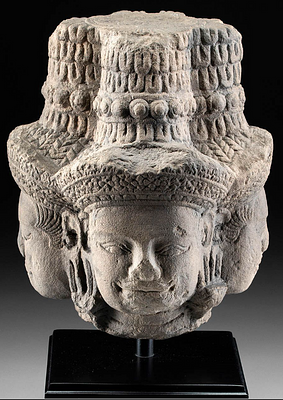19th C. Yupik Wood Dance Mask, Restored by C. McIntyre
Lot 120c
About Seller
Artemis Fine Arts
686 S Taylor Ave, Ste 106
Louisville, CO 80027
United States
Selling antiquities, ancient and ethnographic art online since 1993, Artemis Gallery specializes in Classical Antiquities (Egyptian, Greek, Roman, Near Eastern), Asian, Pre-Columbian, African / Tribal / Oceanographic art. Our extensive inventory includes pottery, stone, metal, wood, glass and textil...Read more
Categories
Estimate:
$8,000 - $12,000
Absentee vs Live bid
Two ways to bid:
- Leave a max absentee bid and the platform will bid on your behalf up to your maximum bid during the live auction.
- Bid live during the auction and your bids will be submitted real-time to the auctioneer.
Bid Increments
| Price | Bid Increment |
|---|---|
| $0 | $25 |
| $300 | $50 |
| $1,000 | $100 |
| $2,000 | $250 |
| $5,000 | $500 |
| $10,000 | $1,000 |
| $20,000 | $2,500 |
| $50,000 | $5,000 |
| $100,000 | $10,000 |
| $200,000 | $20,000 |
About Auction
By Artemis Fine Arts
Jun 29, 2023
Set Reminder
2023-06-29 10:00:00
2023-06-29 10:00:00
America/New_York
Bidsquare
Bidsquare : Exceptional Antiquities, Ethnographic and Fine Art
https://www.bidsquare.com/auctions/artemis-gallery/exceptional-antiquities-ethnographic-and-fine-art-13031
Artemis Fine Arts info@artemisgallery.com
Artemis Fine Arts info@artemisgallery.com
- Lot Description
Native American, Northern United States, Alaska, Yupik people, ca. 19th century CE. A wood shamanic dance mask with extending feathers. The mask is in the form of both a abstract face that also forms a bird's body, the red bird head emerges from the "mouth" and the tail panel from the mask's brow. A pair of bent wood canes arch around the masks. These masks were traditionally made under the direction of shamans and had different functions- some might be intended to wear as masks during ceremonies and others may be made to hang in the home for healing or to bring fortune during hunts. The mask was restored by Chuna McIntyre, a Yupik artist and heritage historian. Size: 22" L x 13" W (55.9 cm x 33 cm)
Chuna McIntyre is a Yupik artist, historian, and dancer. He founded the program and curriculum Nunamfca "of our land" to educate and inspire native and non-native people about Yupik traditional culture through storytelling, song, and dance. Masks are an important part of the teaching and storytelling in McIntyre's performances. McIntyre has also consulted with the Metropolitan Museum of Art on the conservation of a Yupik mask made circa 1900; see the Metropolitan Museum website accession number 2017.718.3. He is also the consultant for the Smithsonian Institute for Yupik culture.
Please note this item falls under the Safeguard Tribal Objects of Patrimony Act and is not eligible for international shipping. Native American, Alaska Native, & Native Hawaiian objects are only eligible to ship within the United States
Provenance: private Alamo, California, USA collection, before 2000
All items legal to buy/sell under U.S. Statute covering cultural patrimony Code 2600, CHAPTER 14, and are guaranteed to be as described or your money back.
A Certificate of Authenticity will accompany all winning bids.
We ship worldwide and handle all shipping in-house for your convenience.
#179762Professional restoration by Chuna McIntyre. Areas repainted and restored with legal feathers. Surface wear as expected with use and age, abrasions, and chips. Stable pressure fissures.Condition
- Shipping Info
-
All shipping is handled in-house for your convenience. Your invoice from Artemis Gallery will include shipping calculation instructions. If in doubt, please inquire BEFORE bidding for estimated shipping costs for individual items.
-
- Buyer's Premium



 EUR
EUR CAD
CAD AUD
AUD GBP
GBP MXN
MXN HKD
HKD CNY
CNY MYR
MYR SEK
SEK SGD
SGD CHF
CHF THB
THB















